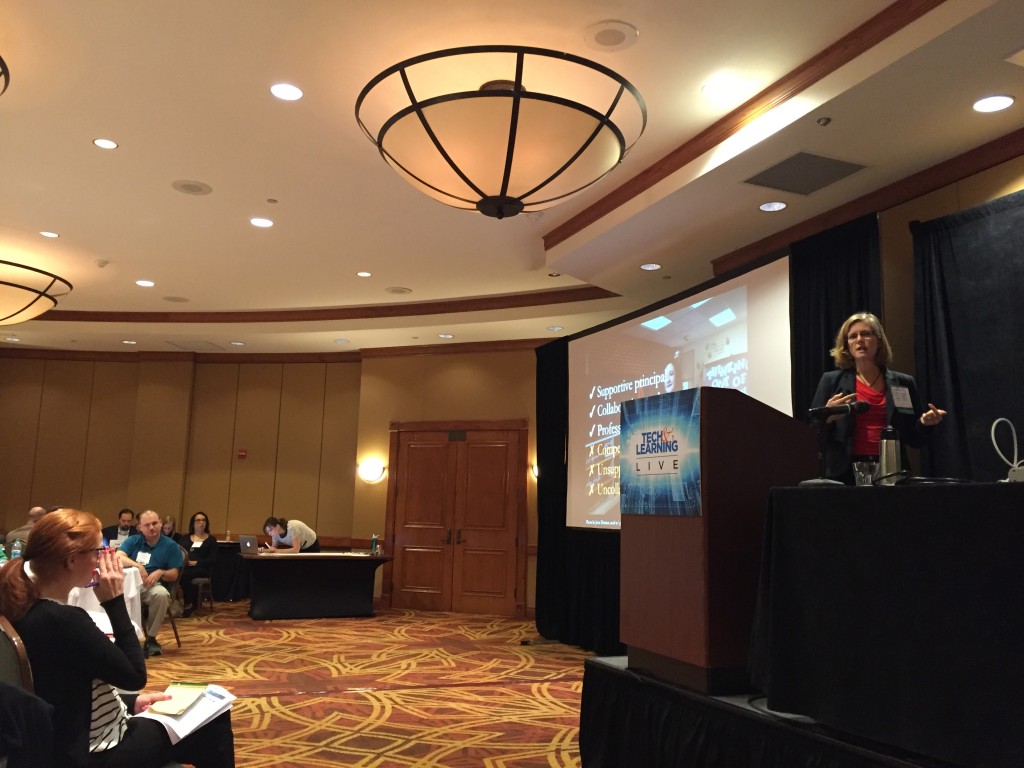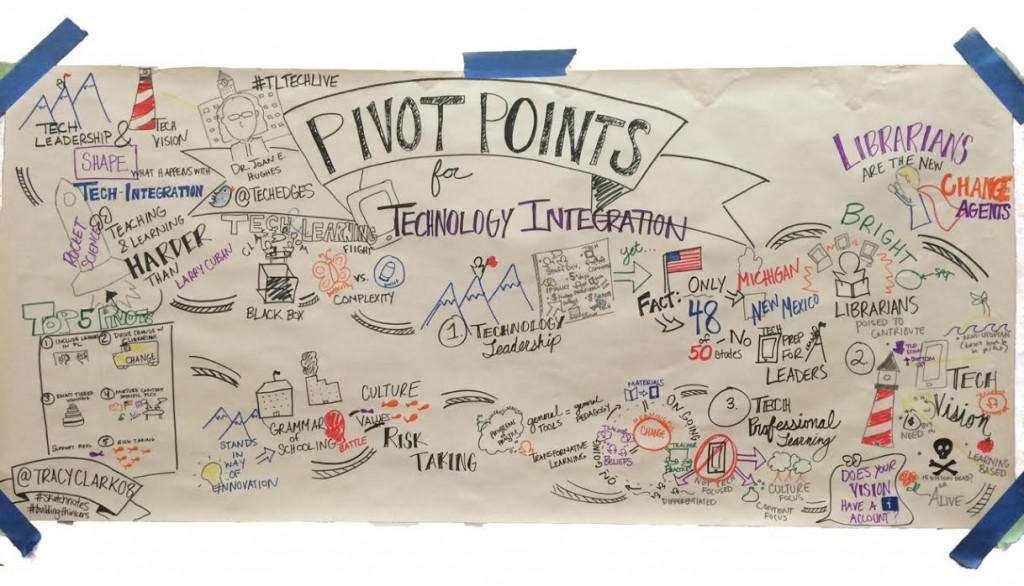5 Pivot Points for Technology Integration
 Yesterday, I keynoted the Tech & Learning Live Austin event. The day was spent considering professional learning and technology integration. In my morning keynote, I shared classroom and school-based research insights on technology integration. Specifically, I talked about how technology leadership, technology vision, and professional learning shape successful technology integration efforts in K-12 schools. The talented Tracy Clark @tracyclark08 sketched the content, which is also included below.
Yesterday, I keynoted the Tech & Learning Live Austin event. The day was spent considering professional learning and technology integration. In my morning keynote, I shared classroom and school-based research insights on technology integration. Specifically, I talked about how technology leadership, technology vision, and professional learning shape successful technology integration efforts in K-12 schools. The talented Tracy Clark @tracyclark08 sketched the content, which is also included below.
I ended the keynote with 5 research-based actions schools can do to pivot towards successful technology integration. They include:
#1: If school leaders must tend to their own technology learning*, we should be inviting them to the professional learning opportunities we arrange in schools and districts. And leaders – you should go! I’ve created opportunities for leaders to engage with actual technology-supported lessons for K-12 learning, and they loved this so much. *Research shows that only 2/50 states require technology preparation course for school leadership degrees, and examination of school leadership curricula reveals 92% of 137 programs do not mention technological courses or preparation. Of the 7%, the technology relates to data-driven decision making, not teaching and learning with technology.
#2: Librarians are the new technology integration change agent*! Use this to your advantage. Hire and cultivate technology-interested librarians and encourage their contributions to your leadership team. *Research shows that librarians contribute to technology leadership activities because of their knowledge of pedagogy, curriculum, technology, and collaboration. Enablers of librarians to do this work include (a) supportive principal, (b) collaborative teachers, and (c) engagement with professional organizations. A disabler is a competitive instructional technologies.
#3: While an optimal technology vision has had input from constituents, not everyone participates in that process*. To increase awareness and buy-in for your technology vision, enact tiered visioning through small groups or PLCs, grade level teams, subject area teams) who develop their own mini technology vision. Think of these mini-visions as a wedding cake – the largest cake bases are built from these small group mini-visions and support and relate to the overarching school or district vision (the top tier). This can enable top-down and bottom-up visioning and enactment at the classroom level. *Research shows more success with technology integration if the technology vision is learner-focused, curricular-focused, and pre-planned in collaboration with stakeholders, such as leaders, technology directors, librarians, teachers, parents, and students. They can emerge from top-down or bottom-up processes as long as the visions are communicated widely and garner buy-in among stakeholders.
#4: Nurture content-specific, ongoing professional learning, such as in professional learning communities (PLCs) that examine problems of practice (POPs)*. If these PLCs have created mini visions (see Pivot #3 above), it’s a logical next step to work on enactment (with support). *To have meaningful, transformative technology integration, research shows the materials (e.g., technologies) must change but that is not sufficient. You must also change teacher beliefs and teacher practices.
#5: If we are asking teachers to change their practices and beliefs, then we must support real risk-taking by working towards cultural change*. *Changing our beliefs and practices will challenge the “grammar of schooling,” which is a school’s engrained educational format and goals. Thus, the kind of change you are working towards will necessitate changes in school culture. School leaders who are successful in technology integration create value and appreciation and support for risk-taking, exploration, and innovation.
This presentation is licensed under a Creative Commons Attribution-NonCommercial-ShareAlike 4.0 International License. Please feel free to share with others, with attribution.
The content of what I spoke about is in the NOTES of the presentation.
 Sketch by Tracy Clark
Sketch by Tracy Clark
4 Questions & Answers about Technology Integration (from a journalist to me)
A journalist, Emily S., is writing a piece about 1:1 technology initiatives for the Highland Lakes Newspapers (The Highlander, Burnet Bulletin, Llano County Journal, Lake Country Life) and requested to ask me some questions. I share the questions and my answers here.
Q: What are some ways technology has changed the typical classroom? What do you think is the biggest change (for teachers, for students)?
Technology does not inherently change classrooms. But some uses of technology can change the approach to instruction shifting it from teacher-centric, teacher-controlled to instruction and learning that is more student-centered. This is more likely to occur when the technology is put in the hands of the students, as opposed to technologies that are teacher-centric, such as projectors, teacher computers, grading and attendance software. Putting technology in the hands of the students can give the learners more agency in their learning, in which they might be able to choose the best way to engage in a task. Or student might even design an inquiry learning task.
Given that, though, 1:1 implementations do not always create such a student-centered learning environment. My research and others in the field also show school classroom environments in which students who all have computing devices simply take notes of teacher lectures or creating presentations that summarize textbook chapters. In these settings, the technology is having no impact toward changing pedagogy or learning.
The biggest change is vastness of information on the Internet and available apps. Schools think that they’ll eliminate textbooks in order to buy laptops or tablets. But this shifts the curricular development onto the shoulders of teachers who are not only trying to learn a new technology but now also have to curate an entire year’s curriculum using open educational resources (educational resources that are available on the internet for free) that are seemingly endless. While the idea of having teachers create their own curriculum and choose resources is amazing, this responsibility cannot just be dropped onto teachers’ shoulders with no notice, support, or resources for development.
Q: How can teachers avoid side-effects of technology, such as decreases in attention spans, being easily distracted?
The best way to avoid students from being distracted (daydreaming, shopping on the internet, ordering take-out for lunch, playing off-task games) is to create vibrant, interesting, motivating lessons that involve students in interactive ways that lead students to developing new knowledge (that solve real problems – even better if the problems are community-based!).
Q: Do you think students are apt to give up more quickly when the answers don’t come easily? (Students might get used to instant answers, in other words…)
Motivational theory puts forth that learners maintain motivation when given series of short, attainable goals that have importance. Designing instructional activities, then, would lead a teacher not to create assessments that have short, instant answers, but instead are complex problems that require inquiry. The answers are unique and are not necessarily known already by the teacher or the students. Through the inquiry, the teacher would work with students in developing small goals that, as each are completed, help the students move farther towards solving the larger problem.
Overall, students are not motivated by worksheets that ask for one answer, which reflects information easily found in textbooks or on the Internet.
Q: Do you think using technology in the classroom makes students less sociable? How can teachers avoid this pitfall?
For the most part, I do not think that technology in the classroom makes students less sociable. But it all depends on how the teacher organizes the use of technology.
If the teacher implements a “personalized” tutoring software in which students put on earphones and listen to problems on a computer screen and answer multiple choice questions individually, then YES this approach to the use of technology makes students less sociable.
If the teacher implements an inquiry-based lesson in which students (in groups) are using tablets to collect data about our social world, pull the data into data analysis software (such as spreadsheet or visualization tools) and find answers to the inquiry, then NO, technology IS supporting social learning, which is optimal for learning to occur.Most contemporary technologies are social and interactive technologies. Educational apps that do not have features that allow collaboration, sharing, and publication are not supportive of optimal pedagogy and learning.
The general public can simply reflect on what technologies motivate them to engage? They will most likely realize the technologies they are excited to be involved in involve small doable challenges (video games with levels), social interaction with other people (Facebook, twitter), interest-based social groups (the biking club, the knitting club), creating or sharing (e.g., a writers group, photography site).